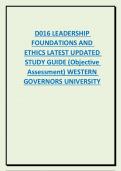lOMoAR cPSD| 19857451
D016 LEADERSHIP
FOUNDATIONS AND
ETHICS LATEST UPDATED
STUDY GUIDE (Objective
Assessment) WESTERN
GOVERNORS UNIVERSITY
, lOMoAR cPSD| 19857451
1
Leadership Foundations and Ethics
D016
Study Guide for the Objective Assessment
Unit 1 – Introduction – N/A
Unit 2 – Building Inclusive Culture and Community
Module 1: Mission, Vision, and Core Values
1. Definition, compare/contrast, and role within school
- Mission Statement - PRESENT, written by BOE
attempt to articulate the purpose of why the school exists and is foundational for the future success of
society
intend to articulate values, priorities, and ethos
- Vision Statement - FUTURE, written by faculty & staff while being led by leadership
- Core Values – terms of practice that clearly define how everyone will work together to
achieve the school's vision and carry out its mission. Core values are not aspirations,
and they are not self-congratulatory; they are practical.
2. Evidence and Impact of Mission, Vision, and Core Values
3. Internal Stakeholders of Mission, Vision, and Core Values
4. External Stakeholders of Mission, Vision, and Core Values
Module 2: Building Community
1. Conversational Leadership – Define, Six Processes and examples
a. Define: the leader’s intentional use of conversation as a core process to cultivate the collective
intelligence needed to create business and social value (Carolyn Baldwin); it encompasses a way of
seeing, a pattern of thinking, and set of practices that are particularly important today, when the most
important questions we face are complex ones that requires us to develop new ways of thinking
together to foster positive change
b. *Clarify purpose and strategic intent -->
*Explore critical issues and questions -->
*Engage all key stakeholders -->
*Skillfully use collaborative social technologies
*Guide collective intelligence toward effective action
*Foster innovative capacity development
, lOMoAR cPSD| 19857451
2
*welcomed open dialogue and made crucial changes to original plan (incentives, positive turns on what
was previously perceived as negative)
*transparency in decision-making --> in the absence of transparency, conspiracy is born and trust is
dismantled (J. Marin)
2. Define and discuss role of each in building community
- Trust:
Trust Building. As the term implies, trust building involves creating a climate in which employer and
employees perceive the organization as a “winwin” environment (Covey, 1991). Sosik and Dionne (1997)
describe trust building as “the process of establishing respect and instilling faith into followers based on
leader integrity, honesty, and openness” (p. 450). Leaders establish an atmosphere of trust by their daily
actions. Specific actions leaders must exhibit include knowing the concerns of employees, knowing what
motivates employees, and knowing the necessary conditions for employees to operate at levels of
maximum effectiveness.
leaders invite & facilitate honest, direct feedback, and when needed, candid and courageous
conversations; so educators can take risks, show vulnerability, and explore new practices that lead to
increased student achievement
Leaders manage trust by demonstrating that they are reliable, congruent, and consistent in their beliefs.
The leader staying connected to the faculty causes a feeling of empowerment, and it is more likely that
staff will commit to goal attainment; if individuals in the internal or external environment refrain from
communicating with the leader, school goal attainment will be extremely difficult, if not impossible
EMPOWERED WORK TEAMS = LEADER HAVING POWER WITH OTHERS, NOT POWER OVER OTHERS --> I
AM SUPPORTING LEADERS (OF EACH STAKEHOLDER: TEACHERS, PARENTS, CLERICAL STAFF, CUSTODIAL
STAFF)
BUILDING A CULTURE OF TRUST: In a culture of trust, the leader is consistent in words, actions, and
deeds, and there are no gaps btwn what the leader says, and what the leader does. As a result of the
trust developed btwn the faculty and the leader, faculty members begin to trust one another, and a
framework for interacting is developed. They begin to communicate directly and openly and do not
withhold information or participate in sharing information that has not been verified. When the leader
builds a culture of trust in the school and everyone is treated with dignity and respect, the full
potential of the faculty can be developed, and the school can benefit from informed decision making.
- Transparency
- Inclusion
3. Four components of cultivating a positive professional culture
4. Define and consider within education:
RATIONAL SYSTEMS: only looking at product manufacturing and making sure we’re shipping enough
units




